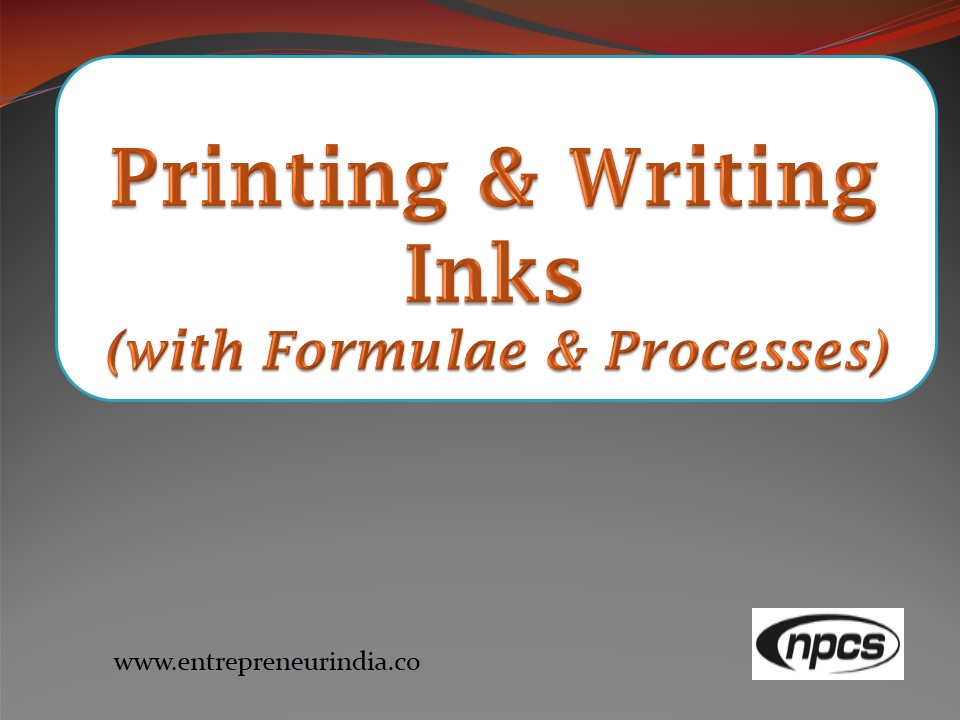
Every print medium—from books and labels to packaging—relies on high-quality inks. Understanding printing writing inks with formulae and processes empowers manufacturers, designers, and printers to achieve consistent color, performance, and safety. This knowledge is essential for producing offset ink, flexographic ink, UV-curable ink, or eco?friendly soy ink. Knowing raw materials, milling techniques, formulation, and drying methods helps create reliable ink batches. Moreover, clear processes ensure compliance with environmental norms and adaptable production. As demand for specialty inks and sustainable options grows, mastering these techniques prepares entrepreneurs and technical specialists to serve evolving printing markets.
Manufacturing Essentials for Printing Writing Inks with Formulae and Processes
Producing printing writing inks with formulae and processes involves systematic selection of ingredients, precise mixing, viscosity control, and quality checks tailored to the intended printing method.
See More – Manufacture Oils & Fats
Raw Materials: Pigments, Binders, Solvents, Additives
Every ink batch begins with four core components:
-
Pigments provide color intensity and opacity. They are finely ground for uniform dispersion.
-
Binders/resins hold pigment particles and help ink adhere to the substrate. Common options include acrylic, cellulose, nitrocellulose, or rosin-modified resins.
-
Solvents adjust flow and drying. Options include water, alcohols, esters, hydrocarbons, glycol ethers depending on ink type.
-
Additives optimize performance: rheology modifiers, wetting agents, dispersants, drying agents, and defoamers.
Selecting and balancing these materials is critical in formulating printing writing inks with formulae and processes.
Grinding and Pigment Dispersion
Color strength and smoothness depend on careful pigment processing:
-
Pigments are first pre-dispersed, then milled using equipment like ball mills, bead mills, or three-roll mills.
-
Proper dispersion breaks agglomerates to achieve fine, uniform particle size for optimal print flow. High shear mixing can prevent settling and improve quality.
This stage ensures consistency for printing writing inks with formulae and processes.
Ink Formulation and Mixing
Once the pigment is ground, formulation proceeds:
-
Add binders, solvents, and additives according to the specific ink recipe.
-
Use precise weighing and controlled mixing to achieve consistent viscosity and color.
-
Color matching is done via spectrophotometric tools to ensure consistency across batches.
With methodical formulation, manufacturers deliver reliable printing writing inks with formulae and processes.
Types of Printing Inks and Process Adaptations
Different printing methods require specific ink formulations:
-
Offset and letterpress inks dry by oxidation or absorption; typically oil-based with vegetable oil, rosin, or mineral oil vehicles.
-
Flexographic and gravure inks are liquid and quick-drying, using solvent or water-based vehicles and appropriate resins.
-
UV-curable inks dry instantly under ultraviolet light using acrylates and photoinitiators. They offer durability and minimal VOC emissions.
Understanding these differences is essential when manufacturing printing writing inks with formulae and processes.
Environmental Variants: Soy, Water-Based, Conductive Inks
Modern ink production also includes eco-conscious and specialty variants:
-
Soy ink uses soybean oil blended with pigment, resin, and wax. Its low VOC content aids recycling and environmental compliance.
-
Water-based inks rely on water as a solvent, ideal for corrugated packaging and paper substrates. They use acidic resins neutralized with ammonia or amine.
-
Conductive inks, containing graphene, silver, or carbon particles, enable printed electronics, RFID tags, and touch sensors. They require complex dispersion with surfactants.
These alternatives expand the scope of printing writing inks with formulae and processes to specialized markets.
Drying, Curing, and Application
After formulation, inks must properly set or cure:
-
Evaporation drying is used in solvent- and water-based inks.
-
Oxidative setting is typical for letterpress/oil inks.
-
UV or EB curing is needed for UV-curable systems.
Proper drying ensures adhesion, color stability, and production speed for printing writing inks with formulae and processes.
Quality Testing and Control
To ensure consistent performance, ink batches undergo critical quality checks:
-
Viscosity, color match, pH, drying speed, adhesion, and rub resistance are tested.
-
Print trials on actual substrates confirm coverage, bleed, and visual quality.
-
Safety tests for VOC content and stability may be mandated.
Robust testing supports reliable production of printing writing inks with formulae and processes.
Equipment and Plant Requirements
A functional ink manufacturing plant includes:
-
Dispersers and mills (bead mills, three-roll or ball mills)
-
High shear mixers for pigment wetting
-
Filtration units, storage tanks, and bulk mixing vessels
-
Quality control lab for viscosity, color, and stability testing
These elements support efficient production of printing writing inks with formulae and processes.
Safety, Regulatory, and Sustainability Aspects
Manufacturing inks involves controlled handling of chemicals:
-
VOC levels should comply with environmental standards when using solvent-based systems.
-
GMP protocols and proper ventilation are essential for worker safety.
-
Eco inks like soy or water-based formulations help reduce environmental impact.
Ensuring safety and sustainability is key in modern ink manufacturing.
Emerging Trends and Future Directions
The ink industry continues innovating:
-
UV-LED curing reduces energy consumption and eliminates mercury lamps.
-
Growth in functional inks such as thermochromic, conductive, or sensor inks enables new product categories.
-
Demand for low-VOC, recyclable, and biodegradable inks is increasing across packaging and publishing sectors.
Keeping pace with these trends is essential to remain competitive in printing writing inks with formulae and processes.
See More – Profit from Your Startup
Conclusion
Producing printing writing inks with formulae and processes demands scientific knowledge, precise formulation, efficient milling, and fine-tuned quality control. From traditional offset and flexographic inks to eco?friendly soy formulations and high-tech conductive inks, each application requires unique ingredient selection, mixing techniques, and curing methods. With proper plant setup, safety measures, and testing, manufacturers can create reliable, compliant, and market-aligned inks. Staying updated with trends—such as UV-LED cures, low-VOC variants, and functional inks—ensures relevance in evolving print and packaging markets. Mastering these processes remains essential for technology-driven ink production and innovation.





